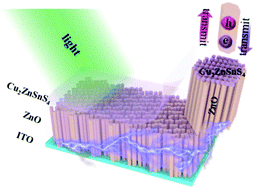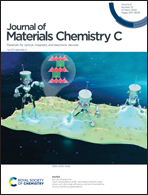Coaxially enhanced photocarrier transport of a highly oriented Cu2ZnSnS4/ZnO photodetector through the nanoconfinement effect†
Abstract
Nontoxic self-powered ZnO-based photodetectors are highly desired to meet the great demand for sensing, communication, and imaging applications, while directionally manipulating the confined photocarrier transport is critical to the enhancement in the photodetection performance. Herein, we demonstrated a highly c-axis-oriented Cu2ZnSnS4/ZnO (CZTS/ZnO) photodetector with coaxially enhanced photocarrier transport. This CZTS/ZnO photodetector delivers remarkable 31 times higher photocurrent mainly ascribed to the coaxially enhanced photocarrier transport in the vertically directed ZnO arrays through the nanoconfinement effect along with the substantially enhanced incident photon absorption of length-optimized ZnO nanorods (NRs). Furthermore, this photodetector delivers a high responsivity of 1.1 μA W−1, fast rise time of 600 ms, and decay time of 600 ms as well as good stability with no distinct photocurrent decay after 2500 cycles. This study will open up a coaxially enhanced photocarrier transport way to substantially improve the photodetection performance and may promote the development of next-generation optoelectronic devices.



 Please wait while we load your content...
Please wait while we load your content...